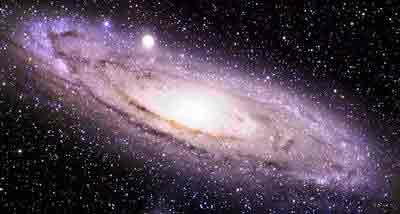|
     
> History
>
Life Cycle of Galaxy
> Types of Galaxies
> Distribution of
Galaxies
> Milky Way Galaxy
> Andromeda
Galaxy
      
|
A 10th-century Persian
astronomer, al-Sufi, is credited with first describing the faint patch of
light in the constellation Andromeda that we now know to be a nearby
galaxy to our own. In 1610, Galileo Galilei used a telescope to study the
bright band on the night sky known as the Milky Way and discovered that it
was composed of a huge number of faint stars. In a treatise in 1755,
Immanuel Kant, drawing on earlier work by Thomas Wright, speculated
(correctly) that the galaxy might be a rotating body of a huge number of
stars, held together by gravitational forces akin to the solar system but
on much larger scales. The resulting disk of stars would be seen as a band
on the sky from our perspective inside the disk. Kant also conjectured
that some of the nebulae visible in the night sky might be separate
galaxies.
 |
Andromeda Galaxy
The Andromeda Galaxy, a spiral galaxy
similar to our own, though somewhat larger. It is the farthest
object that is visible with the naked eye. It can be seen in the
northern-sky constellation Andromeda. The Milky Way and
Andromeda
galaxies are the dominant members of the Local Group of galaxies,
which in turn is an outlying part of the Virgo Cluster, which
comprises thousands of galaxies. |
Towards the end of the 18th century,
Charles Messier compiled a catalog containing the 109 brightest nebulae,
later followed by a catalog of 5000 nebulae assembled by William Herschel.
In 1845, Lord Rosse constructed a new telescope and was able to
distinguish between elliptical and spiral nebulae. He also managed to make
out individual point sources in some of these nebulae, lending credence to
Kant's earlier conjecture. However, the nebulae were not universally
accepted as distant separate galaxies until the matter was settled by
Edwin Hubble in the early 1920s using a new telescope. He was able to
resolve the outer parts of some spiral nebulae as collections of
individual stars and identified some Cepheid variables, thus allowing to
estimate the distance to the nebulae: they were far too distant to be part
of the Milky Way. In 1936, Hubble produced a classification system for
galaxies that is used to this day, the Hubble sequence.
The first attempt to describe the shape of the Milky Way and the position
of the Sun within it was carried out by William Herschel in 1785 by
carefully counting the number of stars in different regions of the sky.
Using a refined approach, Kapteyn in 1920 arrived at the picture of a
small (diameter ~15 kiloparsecs) ellipsoid galaxy with the Sun close to
the center. A different method by Harlow Shapley based on the cataloging
of globular clusters lead to a radically different picture: a flat disk
with diameter ~70 kiloparsecs and the Sun far from the center. Both
analyses failed to take into account the absorption of light by
interstellar dust present in the galactic plane; once Robert Julius
Trumpler had quantified this effect in 1930 by studying open clusters, the
present picture of our galaxy as described above emerged.
In 1912 the American astronomer Vesto M. Slipher, working at the Lowell
Observatory in Arizona, discovered that the lines in the spectra of all
galaxies were shifted towards the red spectral region . These “red shifts”
were interpreted by his compatriot Edwin Hubble as evidence that all
galaxies are moving away from one another and led to the conclusion that
the universe is expanding.
In 1944, Hendrik van de Hulst predicted microwave radiation at a wave
length of 21 centimeters, resulting from interstellar atomic hydrogen gas;
this radiation was observed in 1951. This radiation allowed for much
improved study of the Galaxy, since it is not affected by dust absorption
and its Doppler shift can be used to map the motion of the gas in the
Galaxy. These observations led to the postulation of a rotating bar
structure in the center of the Galaxy. With improved radio telescopes,
hydrogen gas could also be traced in other galaxies. In the 1970s it was
realized that the total visible mass of galaxies (from stars and gas) does
not properly account for the speed of the rotating gas, thus leading to
the postulation of dark matter.
Beginning in the 1990s, the Hubble Space Telescope yielded improved
observations. Among other things, it established that the missing dark
matter in our galaxy cannot solely consist of inherently faint and small
stars. It photographed the Hubble Deep Field, providing evidence for
hundreds of billions of galaxies in existence in the visible universe
alone. [Back][Top] [Next] |
